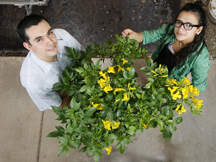Studies give growers tools to bring new tropical plant to Indiana

Roberto Lopez and Ariana Torres developed production protocols for Tecoma stans, a tropical flowering shrub. (Purdue Agricultural Communication photo/Tom Campbell)
WEST LAFAYETTE, Ind. - Purdue University researchers have developed a set of propagation and production protocols that will help Indiana greenhouse growers bring a tropical plant into flower for spring sales.
Roberto G. Lopez, an assistant professor of horticulture, and Arianna P. Torres, a doctoral student in agricultural economics and a former graduate student under Lopez, determined the optimal light intensity, temperature and photoperiod for Tecoma stans, a flowering shrub with yellow, trumpetlike flowers. Their findings, based on seeds and seedlings grown under varying light and temperature conditions, were published in two papers in the journal HortScience.
"We wanted to introduce a new flowering patio or bedding plant to Indiana, and we believe that because of its exotic physical attributes, there is a market here," Torres said.
Not surprising since it is native to Central and South America, Tecoma stans needs a lot of light and warmth. But the plant's need for 14 or more hours of light per day to flower, also called photoperiod, did surprise the researchers.
"Since it grows near the equator, we didn't expect it to need long days to flower," Lopez said. "It's an energy-intensive crop because it needs supplemental light and warm temperatures, but it can be a profitable crop for growers."
Lopez and Torres also noted that Tecoma stans was not a target of most pests found in Indiana. It also is drought-tolerant.
Tecoma stans is a perennial in its native environment but will not survive Indiana winters. However, it potentially can be overwintered indoors. Lopez said it's likely an annual in Indiana that could be potted or planted in a flowerbed for one season.
Lopez and Torres will develop a Purdue Extension bulletin that will give greenhouse growers detailed specifications needed to grow and induce Tecoma stans into flower.
The Purdue College of Agriculture Agricultural Research Program assistantship and the Ball Horticulture Company funded the research.
Writer: Brian Wallheimer, 765-496-2050, bwallhei@purdue.edu
Sources: Roberto Lopez, 765-496-3425, rglopez@purdue.edu
Ariana Torres, 765-430-7585, torres2@purdue.edu
Ag Communications: (765) 494-2722;
Keith Robinson, robins89@purdue.edu
Agriculture News Page
ABSTRACT
Photosynthetic Daily Light Integral During Propagation of Tecoma stans Influences Seedling Rooting and Growth
Ariana P. Torres and Roberto G. Lopez
Current market trends indicate an increasing demand for unique and exotic flowering crops, including tropical plants. Tecoma stans (L. Juss. Kunth)'Mayan Gold' is a tropical plant that was selected as a potential new greenhouse crop for its physical appearance and drought and heat tolerance. However, in winter and early spring, when propagation occurs, outdoor photosynthetic daily light integral (DLI) can be relatively low. The objective of this study was to quantify the effects of DLI during propagation of Tecoma and to determine optimum DLI levels for seed propagation. Seeds were propagated under 13 mean DLIs ranging from 0.75 to 25.2 mol·m –2·d –1 created by the combination of high-pressure sodium lamps (HPS) and fixed woven shade cloths of varying densities. Thirty-five days after sowing, height, stem diameter, node number, relative leaf chlorophyll content, leaf fresh weight, leaf number, total leaf area, individual leaf area, leaf area ratio, shoot and root dry mass increased as DLI increased. Average internode elongation and specific leaf area decreased at a quadratic and linear rate, respectively, as DLI increased from 0.75 to 25.2 mol·m –2·d –1. These experiments indicate that high-quality Tecoma seedlings were obtained when DLI was 14 to 16 mol·m –2·d –1 during propagation.
ABSTRACT
Photoperiod and Temperature Influence Flowering Responses and
Morphology of Tecoma stans
Ariana P. Torres and Roberto G. Lopez
Tecoma stans (L. Juss. Kunth) 'Mayan Gold' is a tropical flowering plant that was selected as a potential new greenhouse crop for its physical appearance and drought and heat tolerance. The objective of this study was to quantify how temperature during the finishing stage and photoperiod during propagation and finishing stages in?uence growth, flowering, and quality. In Expt. 1, plants were propagated from seed under four photoperiods (9, 12, 14, or 16 h) for 35 days. Under long-day (LD) photoperiods (14h or greater), seedlings were 3.0 to 3.7 cm taller than those propagated under 9-h photoperiods. During the finishing stage, days to first open flower, shoot dry mass, and number of nodes below the terminal in florescence were reduced when plants were grown under LD photoperiods. In addition, number of open flowers and branches increased under LD photoperiods. Few plants developed visible buds when grown under short-day (SD) photoperiods (12 h or less). In Expt. 2, plants were forced at average daily temperatures of 19, 20, or 22°C after transplant. Time to first open flower was reduced by 7 days as temperature increased. Inversely, number of visible buds increased by 57 as temperature increased from 19 to 22°C. Under the experimental conditions tested, the most rapid, complete, and uniform flowering of Tecoma occurred when plants were propagated and finished under LD photoperiods and forced at 22°C.
